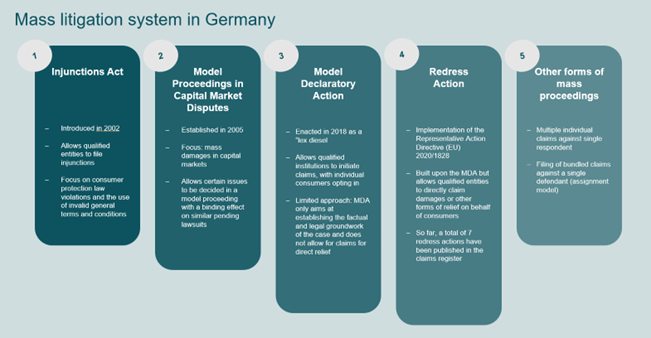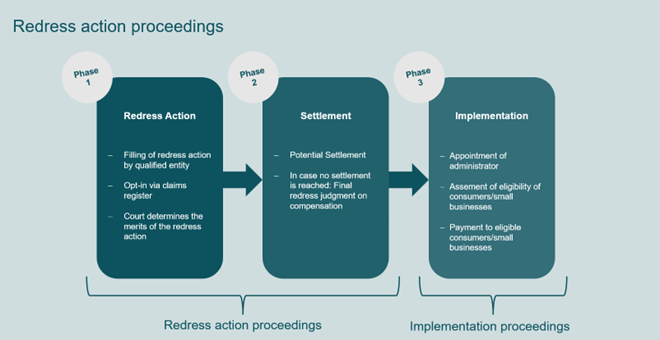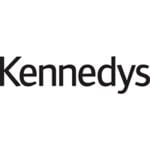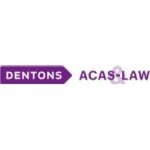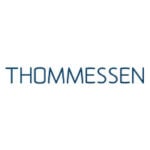-
Does your jurisdiction have a class action or collective redress mechanism? If so, please describe the mechanism and outline the principal sources of law and regulation and its overarching impact on the conduct of class actions in your jurisdiction.
Yes, Germany has several forms of collective redress mechanisms, although traditional U.S.-style class actions are not a feature of German civil procedure law. The principal mechanisms include:
- Injunctions Act (Unterlassungsklagengesetz – UKlaG): Allows qualified consumer and business associations to seek injunctions against unlawful commercial practices.
- Model Proceedings in Capital Market Disputes (KapMuG): Enables certain legal or factual issues in capital markets cases to be decided in a binding model case.
- Model Declaratory Action (Musterfeststellungsklage): Introduced in 2018 to allow qualified consumer organizations to establish general legal and factual issues on behalf of a group of consumers.
- Redress Action (Abhilfeklage): Implemented in 2023 as part of the EU Representative Action Directive (Directive (EU) 2020/1828), this mechanism allows for direct claims for damages or other relief on behalf of consumers and small businesses.
Principal sources of law include the UKlaG, KapMuG, the Code of Civil Procedure (ZPO), and the Consumer Rights Enforcement Act (VDuG).
While the uptake of redress actions has been moderate so far, these mechanisms increasingly shape the landscape of consumer litigation in Germany. Notably, the redress action enables a more efficient process for collective compensation and could lead to a rise in strategic litigation by consumer associations, particularly in areas such as data privacy and ESG.
Picture 1: Overview of collective redress/collective redress-like mechanisms
The individual mechanisms are described in more detail below:
Injunctions Act / Model Proceedings in Capital Market Disputes
Until a couple of years ago, the German legal system has permitted collective redress only under specific conditions, in particular in proceedings under the Injunctions Act (Unterlassungsklagengesetz, UKlaG) pertaining to unfair business practices by companies towards consumers and in proceedings under the Act on Model Proceedings in Capital Market Disputes (Kapitalanleger-Musterverfahrensgesetz, KapMuG) relating to claims based on false, misleading, or omitted capital market information.
Implemented in 2005, the proceedings under the KapMuG entitle investors to assert their claims through so-called model proceedings (Musterverfahren). The proceedings allow certain legal or factual issues related to false, misleading, or incomplete capital market information to be resolved collectively in model proceedings. The decision in the model proceedings then has a binding effect on all pending lawsuits. An application for model proceedings can be filed by the both, claimant and defendant.
The introduction of the KapMuG was prompted by cases like the Deutsche Telekom AG IPO, where thousands of lawsuits were initiated based on alleged false prospectus information. Other notable proceedings under the KapMuG include lawsuits involving Volkswagen AG and Mercedes-Benz Group AG over diesel emissions, Wirecard AG regarding its annual reports, and Bayer AG in relation to the acquisition of Monsanto.
Under the KapMuG, a model proceeding is admissible in situations where at least ten individual claims for damages are brought by investors which all have the same legal and factual basis. Where a model proceeding is permitted, the courts will suspend all other proceedings until a judgment in the model proceedings is reached. This judgment has a binding effect relating to the main issues on all other cases based on the same facts. However, unique features of the individual actions will still have to be decided by the courts in the individual proceedings.
Model Declaratory Action
In 2018, in response to the diesel emissions claims against Volkswagen, Germany introduced the model declaratory action (Musterfeststellungsklage). This legislation took effect in November 2018, just weeks before many claims against VW would have expired due to the statute of limitation.
The model declaratory action is initiated by qualified entities such as consumer protection organizations, rather than by consumers themselves, who do not have standing to initiate these proceedings on their own. Consumers interested in joining a model declaratory action must opt-in by registering their claims in a publicly accessible online claim register (Klageregister). This register includes detailed information about ongoing model declaratory actions, providing summaries of the facts and procedural developments.
Once a model declaratory action has been filed, no other model declaratory action based on the same facts can be initiated, nor can individual lawsuits by consumers who have opted into the action. A judgment in a model declaratory action proceeding binds the participating parties. Consumers who did not opt-in remain unaffected by the judgment. Even for those bound by the outcome, subsequent individual lawsuits may still be necessary to pursue personal damages claims, as the model declaratory action primarily seeks to establish the factual and legal groundwork of the case and does not allow for a claim for direct relief.
The introduction of the model declaratory action has been met with considerable concerns. Some critics noted that the two-step approach, i.e. the differentiation between the model declaratory action as the determination stage and the subsequent individual proceedings in order to obtain an enforceable judgement as inefficient. Furthermore, it was argued that granting consumer associations the right to sue is contrary to core principles of the civil proceedings, which is built upon the concept of private autonomy. Additionally, it was contended that the potential numbers and diversity of potential legal actions in a Model Declaratory Action could overwhelm the financial and organizational resources of the qualified entities.
Redress Action
Most recently, Germany has implemented the EU Representative Action Directive (EU) 2020/1828 by means of the Consumer Rights Enforcement Act (Verbraucherrechtedurchsetzungsgesetz – VDuG) which provides for redress actions as a new collective redress mechanism which will complement the existing mechanisms. Whereas the model declaratory action only allows for declaratory judgments and requires the individual claimants to subsequently initiate individual proceedings to get the desired relief, i.e. payment of damages, the new redress action allows qualified entities to directly claim damages or other forms of relief on behalf of consumers and small businesses, e.g. repair, contract termination, price reduction or purchase price reimbursement.
The relief sought may also be the payment of a total collective amount (kollektiver Gesamtbetrag). The application for a total collective amount is, however, only optional, so that in rather simple cases the claim may also be directed at a direct payment to the consumers.
The general structure and procedure of the redress action aims at addressing the main deficiency of the model declaratory action, namely its two-level approach, and is structured as follows:
Picture 2: Structure of redress action proceedings
Whereas the initial steps (filing of the redress action by a qualified entity, registration of consumers and small businesses with the claim register) are the same as with the model declaratory action, the proceedings before the court are structured differently. In case the court finds the redress action to be generally justified, it shall render a basic redress judgment on the merits of the case (Abhilfegrundurteil). On the other hand, if the court considers the action for redress to be inadmissible or unfounded, it shall dismiss the action by judgment.
In the basic redress judgment the court sets out the specific conditions by which the eligibility of the consumers is determined and the proof of eligibility that is to be provided by each individual consumer in the potential implementation proceedings. After the basic redress judgment has been issued, the court will request the parties to submit a settlement proposal in order to implement the decision by the court. If a settlement cannot be reached and the basic redress judgment becomes legally binding, the court shall continue the redress action proceedings and shall order the initiation of the implementation proceedings (Umsetzungsverfahren) by means of a final redress judgment (Abhilfeendurteil). In the final redress judgment the court shall further render a cost decision.
The implementation proceedings involve the distribution of compensation by an administrator (Sachwalter) who is responsible for establishing an implementation fund (Umsetzungsfonds). The administrator is responsible for determining and verifying the eligibility of the registered customers and small businesses in accordance with the basic redress judgment.
So far, seven redress actions have been published in the claims register. Most of them are linked to price adjustment clauses in General Terms & Conditions (Allgemeine Geschäftsbedingungen). Three of the redress actions concern the alleged invalidity of price increases imposed by energy suppliers upon their customers. One is directed against Vodafone GmbH and also concerns a unilateral price adjustment for internet and telephone services rendered. The newest redress actions pertain to the streaming providers Amazon Prime and DAZN Limited in relation to service adjustments and price increases.
Other proceedings
The rather limited options of collective redress mechanisms available under German law until the implementation of the Representative Action Directive (EU) 2020/1828 have resulted in a rise of claimants filing bundled claims against a single defendant, thereby somehow attempting to mimic a class action-style procedure. Under this assignment model, multiple original claim holder assign their individual claims by means of a fiduciary assignment to a single claimant, which then brings a consolidated action against the defendant. This business model has been gaining traction over recent years due to specialised online platforms.
Under environmental and nature conservation laws, it is further possible for environmental associations to initiate proceedings in administrative courts without being affected in their own rights. This so-called environmental association lawsuit (Umweltverbandsklage) has its legal basis in the Environmental Remedies Act (UmwRG) and the Federal Nature Conservation Act (BNatSchG), as well as the corresponding state regulations. Associations aiming to bring an environmental association lawsuit need to be recognized as environmental or nature conservation associations under § 3 UmwRG.
Besides the above mechanisms, German law provider for further traditional options for two or more claimants to assert claims in civil proceedings, which can, however, not be characterised as collective redress mechanisms. For a simple joinder of parties (einfache Streitgenossenschaft), claimants must either form a community of interest (such as co-owners or joint creditors) or if they are entitled or obligated for the same factual and legal cause. Within a simple joinder of parties, several claims are being combined in joint proceedings which also includes a joint taking of evidence. However, claimants still act independently from one another and are treated individually. German procedural law further provides for a necessary joinder of parties (notwendige Streitgenossenschaft). This mechanism applies where the legal relationship at issue can be established vis-à-vis all parties only uniformly, e.g. in cases that involve issues of joint ownership. Finally, the consolidation of proceedings (Verfahrensverbindung) aims to increase procedural efficiency by consolidating separate proceedings, which have legal ties to one another or which could have been asserted in a single proceeding.
Note: For reasons of clarity and brevity, the following answers focus on the individual aspects of the model declaratory action and the redress action.
-
What is the history of the development of the class actions/collective redress mechanism and its policy basis in your jurisdiction?
See question 1.
Historically, German civil procedure has been grounded in the principle of individual rights enforcement, with proceedings typically binding only the parties involved (inter partes effect). For many years, there was no general mechanism for class actions or collective redress comparable to the U.S. model.
The evolution of collective redress mechanisms in Germany began with targeted legislative responses to specific regulatory gaps:
- 2002 – Injunctions Act (UKlaG): Introduced to strengthen consumer protection by enabling qualified associations to challenge unlawful business practices or invalid contractual terms.
- 2005 – Capital Market Model Proceedings Act (KapMuG): Created in response to mass investor claims, particularly following the Deutsche Telekom IPO. It was designed to handle factually similar cases involving alleged false or misleading capital market information.
- 2018 – Model Declaratory Action (Musterfeststellungsklage): Enacted in response to the Volkswagen diesel emissions scandal. Its primary purpose is to enable the determination of factual or legal issues that affect large groups of consumers, without directly awarding compensation.
- 2023 – Redress Action (Abhilfeklage): Implemented to transpose the EU Representative Action Directive. It significantly expanded the collective redress framework by allowing qualified entities to directly seek compensation and other remedies for consumers and small businesses.
The policy rationale behind these mechanisms lies in improving access to justice for consumers, promoting legal certainty in mass damage cases, and creating efficient judicial procedures while discharging the courts from dealing with countless parallel individual proceedings. The introduction of the redress action in particular reflects a shift towards more comprehensive and effective collective enforcement of consumer rights within the EU framework.
-
What is the frequency of class actions brought in your jurisdiction, in terms of number of cases over the years and/or comparison to other types of litigation?
Despite the introduction of several collective redress mechanisms, class actions remain relatively rare in Germany when compared to traditional individual litigation. The German legislature had initially estimated that around 450 model declaratory actions would be filed annually after the mechanism was introduced in 2018. In reality, only 35 model declaratory actions and 7 redress actions have been published in the claim register to date.
The most prominent case remains the model declaratory action brought against Volkswagen AG in connection with the diesel emissions scandal, where 449,000 consumers registered via the official claim register. One other notable case is the redress action filed by the Consumer Center of Saxony against Amazon Digital Germany GmbH in response to the introduction of advertisements on Amazons streaming platform Prime Video without obtaining customer consent. As of late May 2024, over 100,000 consumers had registered for this action.
Overall, collective proceedings are still the exception rather than the rule in German litigation. That said, the introduction of the redress action has generated considerable interest and may gradually increase the frequency of such proceedings, particularly in consumer-heavy sectors such as banking, energy, telecommunications, and tenancy law.
-
Are there certain courts or types of claims that are most prevalent (for example competition vs commercial litigation generally)?
Collective redress proceedings in Germany are concentrated in specific areas of law, with consumer protection, financial services, energy, telecommunications, and tenancy law being the most common fields.
In terms of court competence, the Higher Regional Court (Oberlandesgericht) in whose district the defendant has its registered office is generally responsible for model declaratory and redress actions (Section 3 (1) VDuG).
Additionally, the governments of the federal states are authorized to designate one specific Higher Regional Court per federal state to handle such actions exclusively, in order to improve procedural efficiency and consistency in judgments. It remains to be seen to what extent this centralization will be used in practice.
Prominent examples of claims include:
- Diesel emissions litigation
- Banking sector disputes (e.g. unlawful interest rate adjustments)
- Energy providers (challenges to unilateral price increases)
- Digital services (e.g. Amazon Prime advertising changes)
-
What is the definition of 'class action' or 'collective redress' relevant to your jurisdiction?
German law does not recognize a universal definition of “class action” in the common law sense. Instead, several distinct procedural mechanisms are available that serve similar purposes under the umbrella of collective redress.
These include:
- Model Declaratory Action (Musterfeststellungsklage) – A procedural tool enabling qualified entities to seek a court ruling on common factual and legal questions that affect a group of consumers. It does not provide for direct relief but establishes a binding legal framework for subsequent individual claims.
- Redress Action (Abhilfeklage) – Introduced in 2023 to implement the EU Representative Actions Directive, this mechanism allows qualified entities to directly seek monetary or non-monetary relief (such as damages, termination, repair, or reimbursement) on behalf of consumers and micro-enterprises.
- Capital Market Model Proceedings (KapMuG) – Used in investor litigation, allowing courts to rule on common factual and legal issues in capital markets cases. The result is binding on all similar pending individual cases.
- Injunctions under the Injunctions Act (UKlaG) – Enable consumer protection associations and certain chambers to enjoin businesses from continuing unlawful practices, especially in relation to unfair terms or misleading advertising.
In summary, collective redress in Germany is a claim-aggregating approach, typically relying on opt-in models and litigation initiated by qualified entities rather than by individual claimants.
-
What are the general 'triggers' for commencement of a class action or collective redress in your jurisdiction from a factual perspective?
Collective redress proceedings are generally triggered by alleged systemic misconduct or alleged uniform harm affecting a large number of consumers (or small enterprises). From a factual perspective, the following elements typically give rise to such proceedings:
- Widespread contractual disputes involving general terms and conditions (e.g. in the energy or telecommunications sectors).
- Mass harm events, such as emissions scandals, data breaches, or financial fraud (e.g. diesel emissions).
- Uniform investor misinformation in capital markets cases (under KapMuG).
For a redress action to be admissible, the claims must be of a similar nature (Gleichartigkeit), meaning they arise from the same or comparable factual circumstances and involve materially similar legal issues. In addition, at least 50 consumers must potentially be affected for a qualified entity to file the action.
This factual similarity of claims is crucial, as it forms the basis for aggregating them into a single redress action. Without such similarity, courts are likely to reject collective redress actions as inadmissible.
-
How do class actions or collective redress proceedings typically interact with regulatory enforcement findings? e.g. competition or financial regulators?
In general, there is no general public enforcement of consumer protection in Germany. In contrast to many other jurisdictions, German law follows a special approach as it does not provide for a general consumer protection authority. Traditionally, consumer protection is predominantly enforced through civil actions. In these actions, qualified institutions, associations, and chambers of industry and commerce have the ability to challenge any alleged violations of laws committed by companies.
However, regulatory enforcement actions, e.g. by competition or financial regulatory bodies, such as the Federal Financial Supervisory Authority (BaFin), may serve as a basis for collective redress claims. When a regulator identifies wrongdoing or breaches of law, such findings may be used by qualified entities to bring model declaratory or redress action on behalf of consumers.
-
What types of conduct and causes of action can be relied upon as the basis for a class action or collective redress mechanism?
See question 6.
Under the redress action regime, claims may also be made for non-monetary relief, such as contract termination, price reduction, replacement or repair of products, and refund of the purchase price.
-
Are there any limitations of types of claims that may be brought on a collective basis?
Yes, while the scope of collective redress mechanisms in Germany is broad, there are certain limitations.
For redress actions under the VDuG, admissibility requires that the claims are of a similar nature (Gleichartigkeit). This means that the claims must arise from the same or comparable factual circumstances, and must involve materially similar legal questions, sec. 15 VDuG.
If the claims are too individualised – e.g. due to differing facts, contracts, or damage calculations—they may not meet the similarity threshold and the redress action may be dismissed as inadmissible.
Moreover, only consumers and small-enterprises (fewer than 10 employees and less than EUR 2 million turnover) may benefit from redress actions, sec. 1 (1) and (2) VDuG.
-
Who may bring class action or collective redress proceeding? (e.g. qualified entities, consumers etc)
Both, the model declaratory action and the redress action, may only be filed by so-called qualified entities on behalf of consumers and/or small businesses, respectively. The term qualified entity refers to qualified consumer protection organizations under German law as well as qualified entities from other EU member states, sec. 2 VDuG.
In order for consumer protection organizations to qualify as a qualified entity it is required that these organisations are registered in the list according to Section 4 of the Injunctions Act (Unterlassungsklagengesetz) and receive no more than 5 percent of their financial resources from company donations. This requirement aims at preventing frivolous collective redress actions.
Small businesses are also considered consumers. Therefore, if a redress action is filed, accession to the proceedings is also possible for small companies. Small companies are those that employ fewer than 10 people and whose annual turnover or annual balance sheet do not exceed EUR 2 million. This extension could particularly become relevant in antitrust actions for damages, which may affect consumers and small businesses alike. The provision that was introduced along with the redress action takes into account the fact that small companies can find themselves in similar economic and psychological situations as consumers. The legal approach of the former model declaratory action regime which did not allow for small business to opt-in via the claims register was subject to criticism in connection with the model declaratory action against VW, as it did preclude commercial vehicle owners from joining the action. Whereas the initial draft of the redress action bill provided to allow redress actions to be joined by small companies with fewer than 50 employees and an annual turnover of up to EUR 10 million, these numbers were reduced in the deliberation process in order to only comprise so-called microenterprises (Kleinstunternehmen).
-
Are there any limits on the nationality or domicile of claimants in class actions or collective redress proceedings?
There are no explicit restrictions based on the nationality or domicile of claimants in German collective redress proceedings.
Qualified entities from other EU Member States are expressly allowed to bring redress actions in Germany, provided they are registered in the EU-wide list of qualified entities under Article 5 of the Representative Actions Directive (EU) 2020/1828, and acting on behalf of consumers or micro-enterprises affected by conduct that occurred in or had an impact on the German market.
Both German and non-German consumers, as well as micro-enterprises, can join a redress action or model declaratory action, provided their claims are within the scope of the case and are registered in the official claim register (Klageregister).
-
Are there any limitations on size or type of class?
There are no statutory limitations on the maximum size of a class in German collective redress proceedings. However, for both the model declaratory action and the redress action, the initiating qualified entity must demonstrate that the action potentially affects at least 50 consumers, sec. 4 (1) VDuG.
-
Are there any requirements or prohibitions in sourcing this class?
Yes, German law contains specific provisions on how consumers and micro-enterprises are identified and included in collective redress proceedings.
For both model declaratory actions and redress actions, participation is based on an opt-in system. This means that:
- Claimants must proactively register their claims in a publicly accessible online claim register (Klageregister) maintained by the Federal Office of Justice.
- Registration must occur prior to a statutory deadline, typically before the first court hearing.
- Only those who register in due time are bound by the judgment or eligible to receive relief.
-
Which courts deal with class actions or collective redress proceedings?
In Germany, both model declaratory actions and redress actions are dealt with by the Higher Regional Court (Oberlandesgericht) in whose district the defendant has its place of business, sec 3(1) VDuG. Appeals against final judgments in both model declaratory actions and redress actions can be filed with the Federal Court of Justice (Bundesgerichtshof).
To promote consistency and efficiency, the federal states (Länder) are authorized to designate a single Higher Regional Court to handle all collective redress cases within their jurisdiction.
In capital markets litigation, model proceedings under the KapMuG are initiated by filing a model proceedings request with the Regional Court (Landgerichte) in an individual case. If admitted, the model proceedings than proceed before the competent Higher Regional Court.
-
Are there any jurisdictional obstacles to class actions or collective redress proceedings?
While German procedural law permits collective redress through qualified entities, jurisdictional challenges may arise in cross-border scenarios, particularly in cases involving non-German defendants.
The EU Representative Actions Directive does not regulate international jurisdiction, but refers to the general provisions of the applicable EU law in this regard. This reference particularly links to Regulation No. 1215/2012 (Brussels I Regulation).
In general, the Brussels I Regulation provides that companies must be sued in their country of domicile, i.e. German companies must be sued in German courts, Art. 4, 63 (1) Brussels I Regulation. However, the Brussels I Regulation provides for various exceptions to this general rule. For example, the regulation provides for special jurisdiction in in matter relating to consumer contracts, Art 17, 18 Brussels I Regulation. In such matters, the consumer may choose to bring proceedings against the other party either in the courts of the Member State in which that party is domiciled or, regardless of the domicile of the other party, in the courts for the place where the consumer is domiciled. According to the case law of the European Court of Justice (ECJ), only the consumer himself can file a claim at the consumer’s place of jurisdiction, but not, for example, a third party to whom the consumer has assigned his claims, even if the third party is himself a consumer (ECJ, judgement of 25.01.2018 – C498/16, ECLI:EU:C:2918:37 – Schrems). The ECJ will have to decide whether this also applies to redress actions or whether qualified entities may be eligible to file a redress action under the special jurisdiction for consumer matters for this purpose, as it is suggested by some legal scholars.
In addition, there is no EU-wide mechanism that coordinates or consolidates parallel collective redress proceedings across Member States. Differences in procedural rules—such as opt-in vs. opt-out systems—further increase legal uncertainty, both for courts and claimants.
-
Does your jurisdiction adopt an “opt in” or “opt out” mechanism?
Germany has implemented an opt-in basis for all forms of collective redress.
-
What is required (i.e. procedural formalities) in order to start a class action or collective redress claim?
First of all, the action must be brought by a qualified entity listed under sec. 4 UKlaG or the EU-wide register pursuant to the Representative Actions Directive. German entities must be independent and may not receive more than 5% of their funding from businesses.
In order for model declaratory or redress actions to be admissible the qualified entity needs to demonstrate that the action may affect the claims of at least 50 consumers or small enterprises.
Furthermore, the statement of claim must include information regarding the similarity of the affected claims of consumers (see question 5). If the qualified entity filing the redress action requests payment of a collective total amount, the statement of claim must also specify the amount of each individual consumer’s claim if all claims of the affected consumers are equal in amount. Otherwise, the method by which the respective individual claims of the affected consumers can be calculated should be indicated.
If litigation funding is used, this must be disclosed. Funding must not come from competitors or parties with a conflict of interest.
-
What other mandatory procedural requirements apply to these types of matters?
A key procedural requirement in German collective redress proceedings is the registration of affected consumers or micro-enterprises in the official claim register (Klageregister). Furthermore, the decision on the admissibility of the redress or model declaratory action and relevant case details are to be published in the claim register as well.
-
Are normal civil procedure rules applied to these proceedings or a special set of rules adopted for this purpose?
Collective redress proceedings in Germany are governed by a hybrid framework: The proceedings largely follow the general rules of civil procedure set out in the German Code of Civil Procedure (Zivilprozessordnung, ZPO). However, both the Model Declaratory Action and the Redress Action are subject to additional procedural rules contained in the VDuG. These special rules address key procedural aspects such as: filing requirements and admissibility criteria, jurisdiction and court competence, claim registration (opt-in), collective settlement procedures and distribution of compensation via an appointed administrator.
-
How long do these cases typically run for?
Collective redress proceedings are generally considered rather lengthy and procedurally complex, with exact timelines depending on the legal mechanism used and the scope of the case.
As of now, no redress action has been completed. Since this mechanism was only introduced in 2023, no reliable estimates exist. The well-known model declaratory action against Volkswagen AG in the diesel emissions scandal was filed in November 2018 and concluded via settlement in April 2020, after around 1.5 years. Over 400,000 consumers joined the action, and more than 240,000 accepted the settlement, which offered compensation between EUR 1,350 and EUR 6,257 per vehicle, depending on model and age.
-
What remedies are available to claimants in class action or collective redress proceedings?
See question 1. Whereas the model declaratory action only aims at establishing the factual and legal groundwork of the case and does not provide for direct relief, the redress action allows the qualified entity to directly assert claims for damages on behalf of the consumers. Besides compensation for damages the redress action may also inter alia be directed at repairment of defective products, termination of contracts, price reductions or purchase price reimbursements.
-
Are punitive or exemplary damages available for class actions or collective redress proceedings?
No. Punitive or exemplary damages are not available under German law, including in the context of collective redress proceedings.
-
Is a judge or multiple judges assigned to these cases?
Collective redress proceedings in Germany are handled by judicial panels composed of multiple professional judges. At the Higher Regional Courts (Oberlandesgerichte), where model declaratory and redress actions are heard, the chambers typically consist of three legally trained judges.
-
Are class actions or collective redress proceedings subject to juries? If so, what is the role of juries?
No.
-
What is the measure of damages for class actions or collective redress proceedings?
Measurement of damages follows the general principles of damage compensation under German law, which is compensatory in nature. The goal is to place the injured party in the position they would have been in had the unlawful conduct not occurred. In redress actions, the court may determine a collective total amount (kollektiver Gesamtbetrag) to be distributed among affected consumers or micro-enterprises. The court may determine the amount of the collective total amount on the basis of its own judgement, taking into account all the circumstances.
-
Is there any mechanism for the collective settlement of class actions or collective redress proceedings?
See question 1.
The German law provides for a distinctive settlement phase in redress actions proceedings which follows the basic judgment (Abhilfegrundurteil). The court will request the parties to submit a settlement proposal within a deadline set by the court. If no settlement is reached, the court will issue a final judgment (Abhilfeendurteil).
-
Is there any judicial oversight for settlements of class actions or collective redress mechanisms?
Settlements in model declaratory or redress action proceedings require the approval of the court. The court shall approve the settlement by order if it considers it to be an appropriate amicable settlement of the dispute, taking into account the facts of the case and the dispute, in particular the interests of the consumers concerned. Otherwise, the court shall refuse to approve the settlement by order.
-
What are the top three emerging business risks that are the focus of class action or collective redress litigation?
Three areas are currently emerging as potential focal points for collective redress litigation in Germany.
- First, data privacy and cybersecurity breaches are gaining relevance, especially as companies increasingly rely on digital infrastructures and face heightened regulatory obligations under the GDPR. Consumers affected by unauthorized data processing, leaks, or breaches may soon be represented in collective actions seeking compensation under Art. 82 GDPR.
- Second, environmental impact and climate change litigation is on the rise, particularly cases involving allegations of greenwashing, misleading ESG claims, or environmental damage caused by business practices.
- Third, employment practices are drawing more attention, especially in relation to gig economy models, misclassification of workers, and violations of working time and wage rules.
-
What trends in litigation are evident in the last three years in your jurisdiction in respect of class actions?
Over the past three years, Germany has seen a noticeable shift in the collective redress landscape, driven by both legislative developments and practical litigation experience. The most significant trend is the implementation of the redress action under the Consumer Rights Enforcement Act, which for the first time allows qualified entities to directly pursue monetary and non-monetary relief on behalf of consumers. Although only a handful of redress actions have been filed to date, they signal growing interest in using this mechanism for large-scale consumer disputes, especially in sectors like energy, telecommunications, and digital services. At the same time, model declaratory actions remain in use but are increasingly viewed as limited due to their two-step structure and the need for follow-up proceedings. Another trend is the rise of digital platforms and legal tech providers facilitating mass claims, which reflects an ongoing professionalisation and commercialisation of collective enforcement
-
Where do you foresee the most significant legal development in the next 12 months in respect of collective redress and class actions?
The most significant legal developments in Germany are likely to center around the practical application and judicial interpretation of the redress action. As courts begin to process the first cases under the new mechanism, key questions will likely arise regarding the required similarity of claims as well as the admissibility of collective total amounts. On the EU level, further clarification may emerge from the ECJ regarding cross-border jurisdictional issues, particularly the role of foreign qualified entities and the interpretation of the Brussels I Regulation in the context of collective redress.
-
Are class actions or collective redress proceedings being brought for ‘ESG’ matters? If so, how are those claims being framed?
While ESG-related claims have not yet been filed under the collective redress regimes in Germany so far, there could be room for ESG-based litigation regarding environmental and climate-related claims, particularly those involving allegations of greenwashing. Companies promoting environmentally friendly products, services, or business practices may face collective redress actions if such claims are found to be misleading or unverifiable.
-
Are there any proposals for the reform of class actions or collective redress proceedings? If so, what are those proposals?
At present, there are no concrete legislative proposals for the reform of class actions or collective redress proceedings in Germany. The redress action under the Consumer Rights Enforcement Act was only recently introduced to implement the EU Representative Actions Directive and is still in its early phase of application.
However, legal scholars and practitioners have already identified potential areas for future improvement. These include simplifying procedural steps, allowing broader access for small businesses, clarifying the admissibility criteria for collective total amounts, and enhancing coordination in cross-border cases to prevent parallel proceedings. Whether and when such proposals will be taken up by the legislature will largely depend on the outcomes of the first redress actions currently pending before the courts and the practical challenges that emerge during implementation.
Germany: Class Actions
This country-specific Q&A provides an overview of Class Actions laws and regulations applicable in Germany.
-
Does your jurisdiction have a class action or collective redress mechanism? If so, please describe the mechanism and outline the principal sources of law and regulation and its overarching impact on the conduct of class actions in your jurisdiction.
-
What is the history of the development of the class actions/collective redress mechanism and its policy basis in your jurisdiction?
-
What is the frequency of class actions brought in your jurisdiction, in terms of number of cases over the years and/or comparison to other types of litigation?
-
Are there certain courts or types of claims that are most prevalent (for example competition vs commercial litigation generally)?
-
What is the definition of 'class action' or 'collective redress' relevant to your jurisdiction?
-
What are the general 'triggers' for commencement of a class action or collective redress in your jurisdiction from a factual perspective?
-
How do class actions or collective redress proceedings typically interact with regulatory enforcement findings? e.g. competition or financial regulators?
-
What types of conduct and causes of action can be relied upon as the basis for a class action or collective redress mechanism?
-
Are there any limitations of types of claims that may be brought on a collective basis?
-
Who may bring class action or collective redress proceeding? (e.g. qualified entities, consumers etc)
-
Are there any limits on the nationality or domicile of claimants in class actions or collective redress proceedings?
-
Are there any limitations on size or type of class?
-
Are there any requirements or prohibitions in sourcing this class?
-
Which courts deal with class actions or collective redress proceedings?
-
Are there any jurisdictional obstacles to class actions or collective redress proceedings?
-
Does your jurisdiction adopt an “opt in” or “opt out” mechanism?
-
What is required (i.e. procedural formalities) in order to start a class action or collective redress claim?
-
What other mandatory procedural requirements apply to these types of matters?
-
Are normal civil procedure rules applied to these proceedings or a special set of rules adopted for this purpose?
-
How long do these cases typically run for?
-
What remedies are available to claimants in class action or collective redress proceedings?
-
Are punitive or exemplary damages available for class actions or collective redress proceedings?
-
Is a judge or multiple judges assigned to these cases?
-
Are class actions or collective redress proceedings subject to juries? If so, what is the role of juries?
-
What is the measure of damages for class actions or collective redress proceedings?
-
Is there any mechanism for the collective settlement of class actions or collective redress proceedings?
-
Is there any judicial oversight for settlements of class actions or collective redress mechanisms?
-
What are the top three emerging business risks that are the focus of class action or collective redress litigation?
-
What trends in litigation are evident in the last three years in your jurisdiction in respect of class actions?
-
Where do you foresee the most significant legal development in the next 12 months in respect of collective redress and class actions?
-
Are class actions or collective redress proceedings being brought for ‘ESG’ matters? If so, how are those claims being framed?
-
Are there any proposals for the reform of class actions or collective redress proceedings? If so, what are those proposals?
